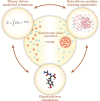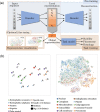Theoretical and Data-Driven Approaches for Biomolecular Condensates
- PMID: 37171907
- PMCID: PMC10375482
- DOI: 10.1021/acs.chemrev.2c00586
Theoretical and Data-Driven Approaches for Biomolecular Condensates
Abstract
Biomolecular condensation processes are increasingly recognized as a fundamental mechanism that living cells use to organize biomolecules in time and space. These processes can lead to the formation of membraneless organelles that enable cells to perform distinct biochemical processes in controlled local environments, thereby supplying them with an additional degree of spatial control relative to that achieved by membrane-bound organelles. This fundamental importance of biomolecular condensation has motivated a quest to discover and understand the molecular mechanisms and determinants that drive and control this process. Within this molecular viewpoint, computational methods can provide a unique angle to studying biomolecular condensation processes by contributing the resolution and scale that are challenging to reach with experimental techniques alone. In this Review, we focus on three types of dry-lab approaches: theoretical methods, physics-driven simulations and data-driven machine learning methods. We review recent progress in using these tools for probing biomolecular condensation across all three fields and outline the key advantages and limitations of each of the approaches. We further discuss some of the key outstanding challenges that we foresee the community addressing next in order to develop a more complete picture of the molecular driving forces behind biomolecular condensation processes and their biological roles in health and disease.
Conflict of interest statement
The authors declare the following competing financial interest(s): T.P.J.K. is a co-founder of Transition Bio and K.L.S., D.Q., and T.P.J.K. are consultants or employees.
Figures









References
Publication types
MeSH terms
LinkOut - more resources
Full Text Sources
Miscellaneous

